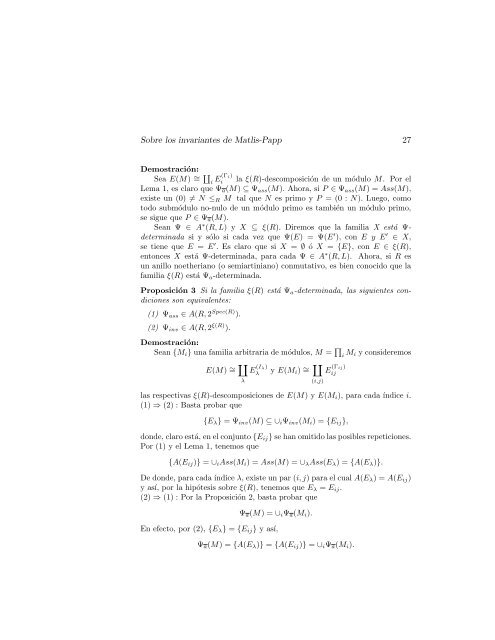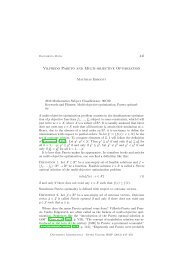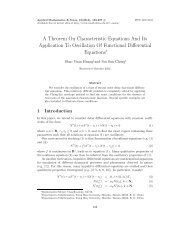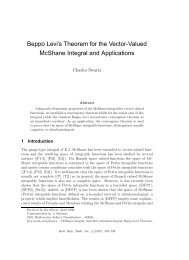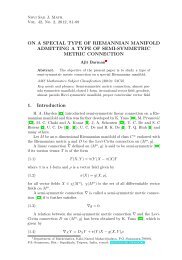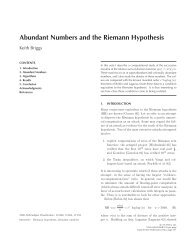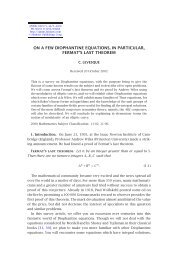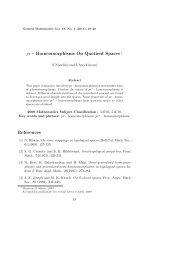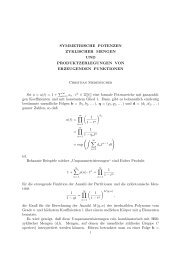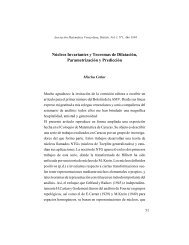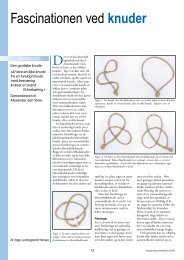Sobre los Invariantes de Matlis-Papp ∗
Sobre los Invariantes de Matlis-Papp ∗
Sobre los Invariantes de Matlis-Papp ∗
You also want an ePaper? Increase the reach of your titles
YUMPU automatically turns print PDFs into web optimized ePapers that Google loves.
<strong>Sobre</strong> <strong>los</strong> invariantes <strong>de</strong> <strong>Matlis</strong>-<strong>Papp</strong> 27<br />
Demostración:<br />
Sea E(M) ∼ = ∐ i E(Γ i)<br />
i la ξ(R)-<strong>de</strong>scomposición <strong>de</strong> un módulo M. Por el<br />
Lema 1, es claro que Ψ a (M) ⊆ Ψ ass (M). Ahora, si P ∈ Ψ ass (M) = Ass(M),<br />
existe un (0) ≠ N ≤ R M tal que N es primo y P = (0 : N). Luego, como<br />
todo submódulo no-nulo <strong>de</strong> un módulo primo es también un módulo primo,<br />
se sigue que P ∈ Ψ a (M).<br />
Sean Ψ ∈ A <strong>∗</strong> (R, L) y X ⊆ ξ(R). Diremos que la familia X está Ψ-<br />
<strong>de</strong>terminada si y sólo si cada vez que Ψ(E) = Ψ(E ′ ), con E y E ′ ∈ X,<br />
se tiene que E = E ′ . Es claro que si X = ∅ ó X = {E}, con E ∈ ξ(R),<br />
entonces X está Ψ-<strong>de</strong>terminada, para cada Ψ ∈ A <strong>∗</strong> (R, L). Ahora, si R es<br />
un anillo noetheriano (o semiartiniano) conmutativo, es bien conocido que la<br />
familia ξ(R) está Ψ a -<strong>de</strong>terminada.<br />
Proposición 3 Si la familia ξ(R) está Ψ a -<strong>de</strong>terminada, las siguientes condiciones<br />
son equivalentes:<br />
(1) Ψ ass ∈ A(R, 2 Spec(R) ).<br />
(2) Ψ inv ∈ A(R, 2 ξ(R) ).<br />
Demostración:<br />
Sean {M i } una familia arbitraria <strong>de</strong> módu<strong>los</strong>, M = ∏ i M i y consi<strong>de</strong>remos<br />
E(M) ∼ ∐<br />
= E (I λ)<br />
λ<br />
y E(M i ) ∼ ∐<br />
= E (Γ ij)<br />
ij<br />
λ<br />
las respectivas ξ(R)-<strong>de</strong>scomposiciones <strong>de</strong> E(M) y E(M i ), para cada índice i.<br />
(1) ⇒ (2) : Basta probar que<br />
(i,j)<br />
{E λ } = Ψ inv (M) ⊆ ∪ i Ψ inv (M i ) = {E ij },<br />
don<strong>de</strong>, claro está, en el conjunto {E ij } se han omitido las posibles repeticiones.<br />
Por (1) y el Lema 1, tenemos que<br />
{A(E ij )} = ∪ i Ass(M i ) = Ass(M) = ∪ λ Ass(E λ ) = {A(E λ )}.<br />
De don<strong>de</strong>, para cada índice λ, existe un par (i, j) para el cual A(E λ ) = A(E ij )<br />
y así, por la hipótesis sobre ξ(R), tenemos que E λ = E ij .<br />
(2) ⇒ (1) : Por la Proposición 2, basta probar que<br />
Ψ a (M) = ∪ i Ψ a (M i ).<br />
En efecto, por (2), {E λ } = {E ij } y así,<br />
Ψ a (M) = {A(E λ )} = {A(E ij )} = ∪ i Ψ a (M i ).


